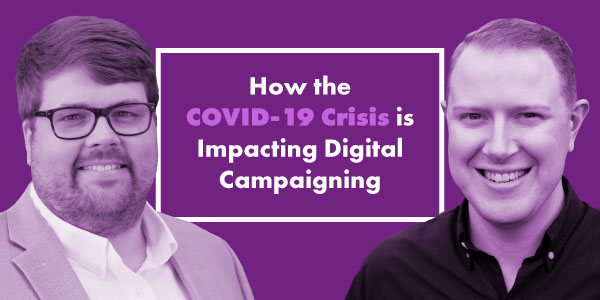
By Wayne Yocum, Chief Creative Officer
Over the last several election cycles, one of the overarching trends in political communications has been the emergence, rapid adoption, and predicted dominance of digital and social media. Victory Enterprises is lucky to have two of the pioneers of digital campaigning on our staff, Chief Development Officer Joe Lakin and Digital Director Charlie Puyear.
I sat down with them to talk about how the current COVID-19 pandemic is impacting the adoption and use of digital and social media in political marketing.
1. When did digital and social media become a significant messaging channel for political campaigns?
Charlie Puyear – Digital has been on a steady climb for most campaigns since 2008. Each year, more platforms and ad formats are added while additional rules and regulations have also increased, particularly since 2016.
2. Prior to 2020, to what extent was digital spending growing as a portion of total campaign expenditures?
CP – It really depends. Many digital-only firms will give you a base percentage of 25 or 30 percent. The fact of the matter is, because of Victory Enterprises’ agnostic approach to media delivery, we believe it depends on the district and the cost of other mediums. For example, in a district where linear television is still cost effective, the percentage of digital may be lower. But, on average, our campaigns spend approximately 25 percent of our budgets on digital and social advertising.
3. Is there a difference in how political marketers have adopted digital compared to their commercial/corporate counterparts?
Joe Lakin – There are certainly differences. Politics offers a unique challenge as compared to commercial advertising. For a business, ROI is easily identified. If your advertising and creative expenses exceed sales generated, the ROI is broken and the campaign needs adjustment. In a political campaign, we can easily identify broad ROI in terms of wins and losses but oftentimes not at the individual level. We can know who voted, but not who they voted for. But these metrics fail to adequately measure the efficacy of any individual medium or strategy within a campaign. That’s why we are constantly measuring ad performance during a campaign but also after they’ve ended.
4. How has the COVID-19 pandemic impacted the use of digital and social media by campaigns?
CP – VE was founded to bring a comprehensive, innovative and effective approach to campaigns. Honestly, we are uniquely equipped to pivot and innovate, even in the face of uncertainty like COVID-19. Fortunately, with all of our campaigns, we always invest in early digital infrastructure. That infrastructure is paying off more than ever as traditional tactics are limited AND digital media consumption has skyrocketed over the past month.
Our clients have deployed numerous innovative strategies from online concerts, town halls and outreach to constituents struggling with this crisis. It’s been really cool seeing the platforms and channels we’ve helped our clients build to help them and their voters during these unique times.
5. Are those channels now the dominant means campaigns use to reach voters?
CP – Digital channels dominate the non-fundraising function of any campaign until the paid media persuasion phase begins in the final weeks or months. Effective channels are essential for early branding, positioning and first impressions for voters. Once they’re built, they become the channel for reaching new voters, engaging contacts and evangelizing supporters. Every channel should have content for each of those three tactics throughout the campaign. Once the paid media persuasion begins, the better the channels the quicker the persuasion will occur.
6. Is digital a replacement for traditional means of messaging, or a supplement/complement to them? In what ways can digital enhance the impact of traditional message channels?
JL – Digital hasn’t completely replaced traditional messaging but it’s amplified its impact and increased the speed of delivery. Before digital, a campaign’ s only non-paid method of communication with voters was earned media. It can take years of earned media to saturate messages with audiences. With digital, campaigns can more quickly identify supporters, engage them and activate them. Traditional means are still important but digital is dominant in terms of impressions and impact.
7. What is the worst thing a campaign could be doing today, in terms of digital?
JL – In today’s crisis, the worst thing you can do is nothing. Voters are consuming content, looking for leadership and still discerning what candidates stand for even during this crisis. Furthermore, the cost of advertising is down as commercial advertisers have pulled back. This is the highest value window for digital in years, if not ever. Sitting on your hands is the quickest way to get behind and lose.
8. What is the biggest innovation you see on the horizon for digital campaign marketing?
JL – To me, connected TV is the most important digital innovation for campaigns, especially in 2020. With presidential turnout and a small persuadable universe, reaching cord-cutters and hard-to-reach audiences will require effective deployment of a connected TV strategy. If your strategy doesn’t include targeting persuadables on CTV, you’re going to miss a huge swath of highly valuable persuadable voters.
